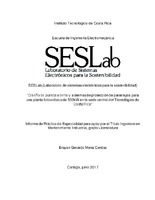| dc.contributor.advisor | Morera-Hidalgo, Julio Andrés. | es |
| dc.contributor.author | Mena-Cerdas, Brayan Gerardo | |
| dc.date.accessioned | 2017-09-06T19:59:26Z | |
| dc.date.available | 2017-09-06T19:59:26Z | |
| dc.date.issued | 2017 | |
| dc.identifier.uri | https://hdl.handle.net/2238/7363 | |
| dc.description | Proyecto de Graduación (Licenciatura en Ingeniería en Mantenimiento Industrial) Instituto Tecnológico de Costa Rica. Escuela de Ingeniería Electromecánica, 2017. | es |
| dc.description.abstract | The concept of grounding refers to the intentional electrical connection with the earth, either from a part of the circuit (system grounding) or from metal parts that do not belong directly to it (equipment grounding). These ground connections must be sufficiently low impedance and ampacity to prevent the formation of dangerous voltages for people or connected equipment and to provide a path for the earth fault current to flow, Facilitate the operation of the protection devices to release the fault. On the other hand, lightning arrester systems must be capable of safely conducting ground current from lightning.
The objective of the present work was to design the grounding system and lightning rods for a 500 kW solar complex located at the headquarters of the Technological Institute of Costa Rica. In addition, the development of a grounding guide for photovoltaic systems in the country.
To achieve this, the design was based and adapted from the IEEE 80 standard, which corresponds to the design of grounding for alternating current substations. The fundamental parameters for obtaining ground designs are the ground resistivity and the maximum fault current. The first was measured with the Wenner method with a value of 98.65 Ωm and the second was determined for the system as the short-circuit current for the PV array that was larger, in this case 103 A. The voltages of touch and step, where the maximum permissible values were 104.06 V and 144.30 V respectively.
The theoretically obtained design will have a resistance of 0.80 Ω, which is less than the 1 Ω value allowed by the standard. The lightning arrestor system was selected with the deionizing technology, since it offers greater security. | es |
| dc.description.sponsorship | Instituto Tecnológico de Costa Rica. SESLab. | es |
| dc.language.iso | spa | es |
| dc.publisher | Instituto Tecnológico de Costa Rica | es |
| dc.rights | acceso abierto | es |
| dc.subject | Puesta a tierra | es |
| dc.subject | Sistema | es |
| dc.subject | Resistividad | es |
| dc.subject | Electrodo | es |
| dc.subject | Sobretensión | es |
| dc.title | Diseño de puesta a tierra y sistemas de protección de pararrayos para una planta fotovoltaica de 500kW en la sede central del Tecnológico de Costa Rica | es |
| dc.type | proyecto fin de carrera | es |


